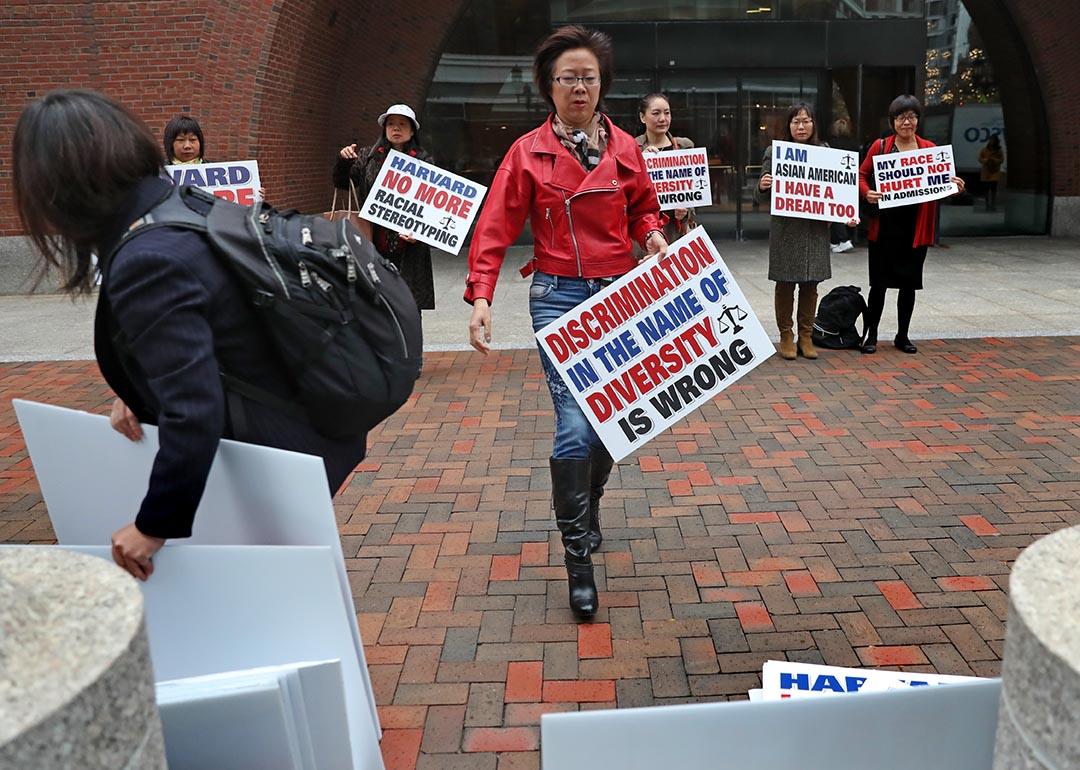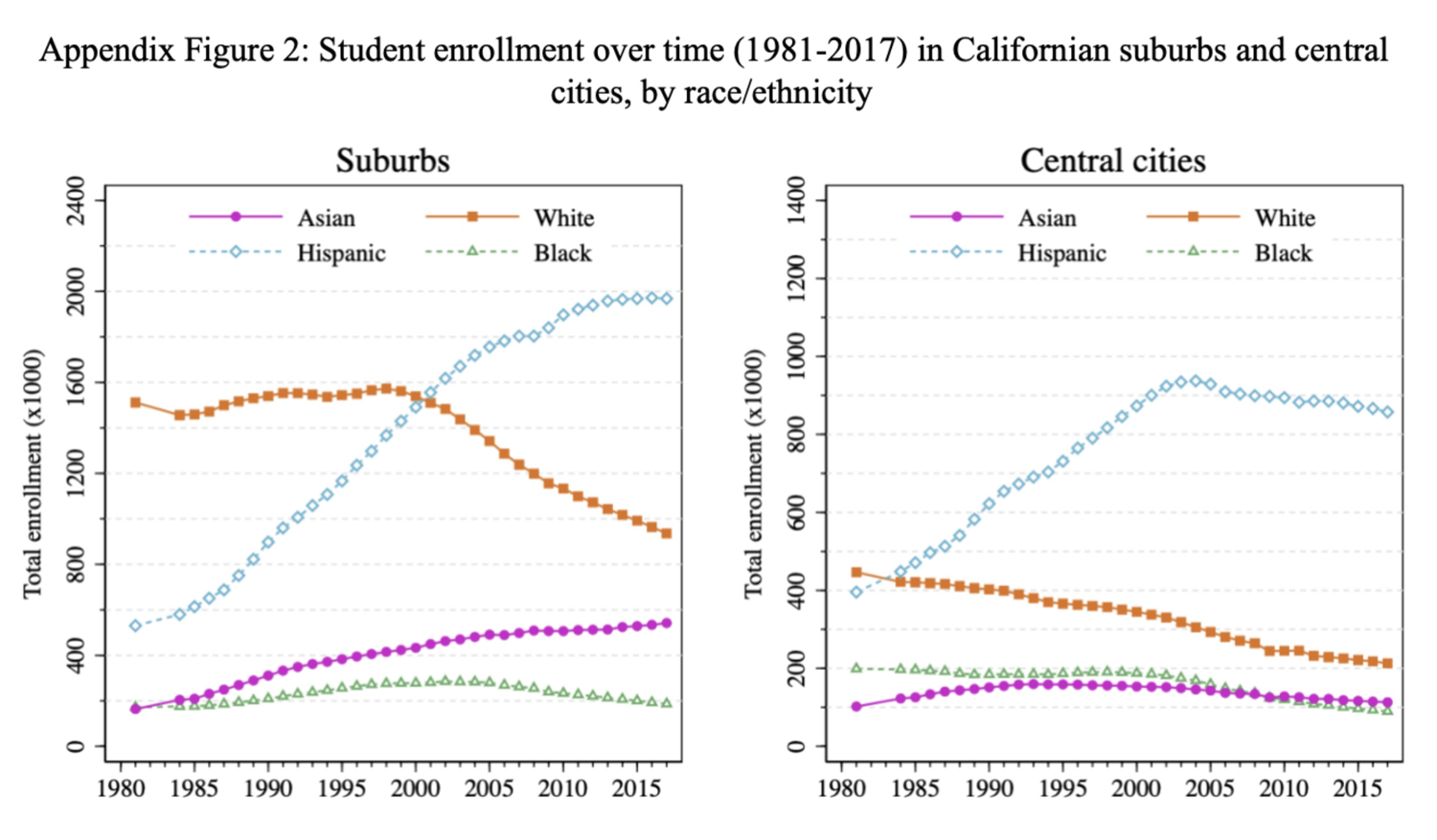
In wealthy, educated communities, evidence emerges of a new form of "white flight"
In wealthy, educated communities, evidence emerges of a new form of "white flight"
Asian Americans increasingly find themselves at the center of scorching debates over educational opportunity and fairness, whether related to admissions practices at highly selective colleges or pressing concerns over social exclusion in school.
Now research evidence demonstrates that they face racial isolation simply by entering the classroom. A recent study of wealthy California suburbs reviewed by The 74 finds that white families drift away from public schools as more Asian students enroll in them — and fears over academic competition, rather than outright racism, may play the biggest role in driving the departures.
Circulated in the summer of 2023 by the National Bureau of Economic Research, the paper offers an unusually granular view of population-level changes in a highly affluent and desirable milieu. It also reveals a stark and somewhat disturbing response to the presence of Asian Americans, one of the fastest-growing and highest-achieving ethnic groups in the United States.
In measure after measure, Asian Americans are shown to be America's top-performing student racial category. The National Assessment of Educational Progress, a federal standardized test often referred to as the Nation's Report Card, has historically found large gaps separating Asian students from their white, African American, and Hispanic peers. Asians achieved similar results on college entrance exams, tallying 43 percent of all test takers scoring over 700 on the SAT math section while making up less than 6 percent of all K–12 students.
Older federal data also show that, apart from testing, Asian high schoolers earn higher GPAs than students of other backgrounds, and the proportion of Asians earning college credit through Advanced Placement or International Baccalaureate coursework is nearly double that of whites.
While they've ascended to lofty altitudes in U.S. schooling — significantly ahead of whites, America's most historically advantaged group, and vastly more so relative to other non-whites — Asian Americans have often received a frosty reception from policymakers and communities. In June, the Supreme Court ruled that the admissions policies at Harvard and the University of North Carolina discriminated against Asian applicants in order to cultivate more racial diversity on their campuses, a historic blow to the legality of affirmative action. And for nearly two decades, news accounts have highlighted areas (including in California cities like Cupertino) where white families disenrolled from local schools following an influx of Asian children, with some parents openly complaining of increased academic competition from the new arrivals.
The new study reveals that those cases were not merely anecdotes. Study co-author Leah Boustan, an economist at Princeton University, has previously investigated instances of postwar "white flight" that saw whites quickly abandon neighborhoods as the percentage of African American inhabitants grew. But at the project's outset, she said, the idea of flight from high-flying schoolchildren seemed "the opposite" of what one would expect from local parents.
"I would have thought that a school district with a growing number of Asian students would be seen as a positive thing," Boustan reasoned. "Because we have these perceptions — partially based on real data about the educational background of Asian parents, but also partially stereotypes that are expanded beyond the reality — that somehow, Asian kids would be better prepared, that they would be better peers who would elevate classroom discussion."

'White kids are generally falling behind'
Those assumptions may indeed have guided the white parents featured in the research, though perhaps not in a predictable direction.
Boustan and her colleagues collected public school enrollment figures from the California Department of Education between 2000 and 2016, which included demographic information about families' racial and socioeconomic backgrounds. They focused on a group of 152 school districts that were suburban and comparatively well-to-do, determined by their local average incomes and percentages of students who qualified for free or reduced-price lunch (a common measure of poverty in education research).
They also used U.S. Census records to determine the growth rates of Chinese, Filipino, Japanese, Korean, Vietnamese, and South Asian students within those districts. Over 6 million people of Asian descent live in California, roughly one-third of their numbers within the United States as a whole, and Asian students make up proportionally larger shares of suburban districts than urban ones. While large divergences exist between Asians of different national origin, on average, households headed by Asian Americans earn 38 percent more than the U.S. median income.
The results of the authors' calculations were unmistakable: With each arrival of an Asian American student in a high-income suburban district, .6 white students left — mostly departing the community entirely, rather than relocating to a private or a charter school. After adjusting their observations for moving patterns (different sub-groups enrolled at schools at markedly different rates, with South Asian and Chinese populations growing faster than Koreans and Japanese) the effect was even greater, such that each Asian student was associated with the departure of 1.5 white students.
The strength of the correlation between Asian entrance and white exit was clear, even if the motivation wasn't. The research team considered multiple explanations behind the trend, but found reason to doubt each.
First off, no statistical relationship existed during those years between Asian American student enrollment and that of students from other groups, such as African Americans or Hispanics; therefore, white movement was a reaction not to the broader emergence of non-white neighbors, but to Asians specifically.
But additional qualitative evidence indicates that the movement was unlikely to have been primarily generated by anti-Asian prejudice either. In responses to the General Social Survey, a long-running poll of public attitudes administered by the University of Chicago's National Opinion Research Center, highly educated participants were vastly less likely than their less educated peers to say they "feel cool" toward Asian Americans, or to say they don't trust them. And yet the suburbs included in the study were overwhelmingly populated by high-income residents with college and advanced degrees.
"If we just look at the basic correlations, we don't see this kind of white flight from low-income suburbs," said Boustan. "To me, this very clearly rules out basic racial animus."
But the out-migration could be related to another factor: relative performance in school. According to results from California's mandated math and reading tests, as well as its high school exit exam, the presence of Asian students in a given school during the period under observation was tied to elevated average test scores in that school — but typically not for white students. In other words, the new Asian American pupils were bringing stronger academic performance to the schools they enrolled in, but also potentially making their white classmates look somewhat worse by comparison.
Boustan said that possibility could be viewed with dread during college admissions season, when high school seniors are often considered on the basis of their class GPA rank.
"Someone is showing up in the district who scores better than they do. On some of the tests, maybe that pulls the white scores up a bit too, and on other tests, it looks like white scores might even be falling. But in relative terms, the white kids are generally falling behind."
'Race at the Top'
The theme of white and Asian families jostling for educational opportunity has been sounded more frequently in recent years, especially in highly educated, middle-class settings. This summer, the Supreme Court's landmark decision in Students for Fair Admission v. Harvard showcased the comparatively superior academic credentials of many Asian applicants to elite universities, as well as the various alternative criteria — including legacy and donor status, racial preferences, extracurricular activities like sports — that colleges use to select their classes.
A similar dynamic plays out during the K–12 years. In 2022, Tufts University sociologist Natasha Warikoo published Race at the Top, an account of fierce academic competition among high schoolers in a wealthy, but unidentified, East Coast community. Some of the white parents she spoke with expressed worry about the high-stakes atmosphere building in their local schools and fear that their own children would struggle to keep pace with their Asian classmates.
Lurking behind the discourse is the decade-old cultural figure of the "Tiger Mother": a hyper-motivated Asian parent who pushes her child to excel in high-level coursework and seek extra instruction outside of class. Viewed as a model by some and an offensive stereotype by others, the notion appears to guide how some white parents perceive their Asian neighbors.
It may also reflect some bedrock truths about what different families prioritize in education and child-rearing. In a study published this summer, researcher Ziyao Tian used microdata from consumer surveys for different families across the U.S. to show that white and Asian families differ dramatically in their annual expenditures on K–12 education. Not only did Asian families outspend white families overall, they were also more likely to direct their spending toward tutoring and instruction outside of school. By comparison, whites outspent Asians on sports and cultural activities like trips to parks, concerts, and museums.
Notably, the gap in expenditures was at its greatest among highly educated families like those populating the California suburbs that Boustan studied. Asian parents with graduate degrees spent 22 percent more on tutoring for their children than similarly credentialed white parents; among parents with a high school education or less, Asians spent just 6 percent more on tutoring. In spite of the escalating disparities in spending, the Asian-white achievement gap is actually greater among families with less educational attainment.
Those findings provide an echo of a 2021 study looking at the incremental growth of private tutoring centers. The number of such brick-and-mortar centers (including many employing the popular Kumon method) more than tripled between 1997 and 2016, an explosion that was heavily concentrated in highly educated and high-income cities and towns. They were also disproportionately likely to be located in areas with larger percentages of immigrant and Asian residents.
Eddie Kim, a mathematics professor at Bentley University and one of the tutoring study's co-authors, said that the purchase of additional learning opportunities outside of traditional schooling might be a partial outgrowth of middle-class status. While the top priority for many striving families is to move to a neighborhood with strong public schools, the same households must pursue alternate routes for their children's academic development after that step has been taken.
"Once you've moved to a particularly good school district, and you see that everyone else is already [academically] good, how do you give your child an advantage? It can't be through the school system because every child gets the same thing," Kim posited. "The only advantage is to look outside the school system."
The findings of the Boustan paper "clicked with" some of Kim's own instincts about middle-class parents' strategies around education and admission. If they feared that their children would be outshone in the classroom, they might well change schools — or even move — he said.
"When you say it out loud, it sounds very intuitive: Of course, parents aren't just going to lie down and do nothing. If they notice something, even semi-subconsciously, they're going to take action to support their individual child's success."
This story was produced by The 74 and reviewed and distributed by Stacker Media.



